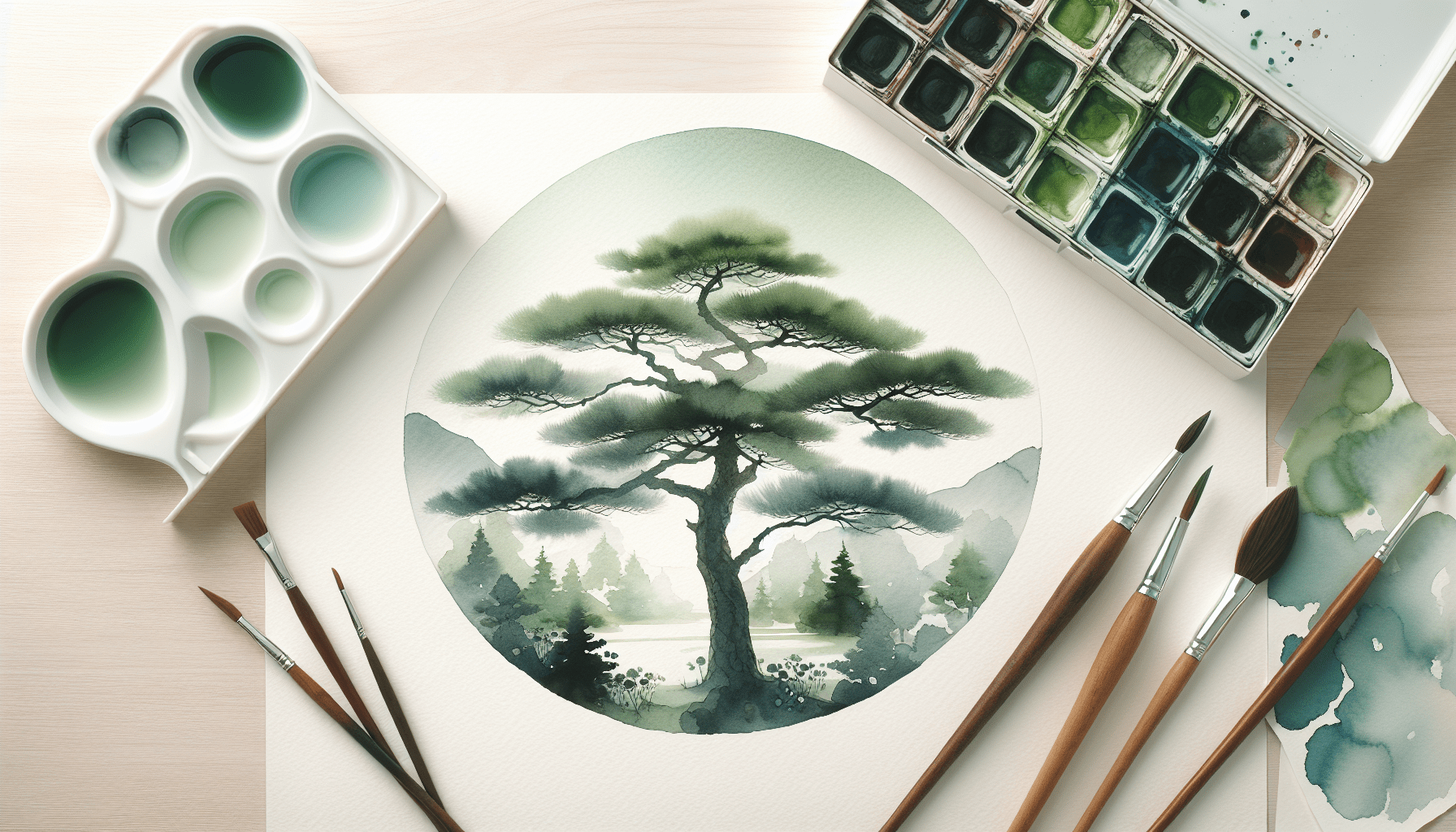In the article “How To Store Watercolor Paintings,” you will find a comprehensive guide to preserving your valuable watercolor artworks with meticulous care. This resourceful guide delves into essential techniques to protect your paintings from environmental factors such as humidity, light, and dust, ensuring their longevity. You will explore best practices for handling, mounting, and framing, as well as the significance of using archival materials. By implementing these strategies, you can maintain the vibrancy and integrity of your watercolor paintings, safeguarding your artistic investments for future generations. Have you ever wondered how to properly store your watercolor paintings to preserve their beauty and value for years? Whether you are a professional artist, an amateur enthusiast, or a collector, understanding how to store watercolor paintings appropriately is crucial to maintaining their longevity and vibrancy.
Introduction to Storing Watercolor Paintings
Watercolor paintings are delicate and sensitive to environmental factors. Proper storage not only ensures that your artwork remains in pristine condition but also protects it from potential damage. This guide will walk you through the essential steps and considerations for storing your watercolor masterpieces.
Understanding the Nature of Watercolor Paintings
Characteristics of Watercolor Paints
Watercolor paints are known for their translucency and delicate appearance. This is achieved by mixing pigments with a water-soluble binder, typically gum arabic. The resulting artwork can be vulnerable to various environmental factors.
Potential Risks
Several risks can impact the longevity of watercolor paintings, including:
- Humidity: Excessive moisture can cause mold growth, which can deteriorate the paper and colors.
- UV Light: Direct sunlight can fade the vibrant colors of watercolor paints.
- Pollutants: Dust, dirt, and airborne chemicals can stain and damage the painting’s surface.

Proper Storage Techniques
Climate Control
Climate control is one of the most critical aspects of storing watercolor paintings. Maintaining an optimal environment is essential to prevent damage.
- Temperature: Aim to keep the storage area at a consistent temperature, ideally between 65°F and 75°F.
- Humidity: Use dehumidifiers or humidifiers to maintain relative humidity levels between 40% and 60%.
Light Exposure
Minimizing light exposure is crucial to preserve the colors of your watercolor paintings. Store artworks in a dark room or use UV-protective materials.
- Avoid Direct Sunlight: Keep paintings away from windows and skylights.
- Use UV-Resistant Glass: If displaying your paintings, frame them with UV-resistant glass to filter harmful rays.
Physical Protection
Taking steps to protect your painting from physical damage is equally important. Here are some methods to ensure physical safety:
Framing
Framing your watercolor paintings helps to provide a barrier against dust, pollutants, and physical impacts.
- Acid-Free Materials: Ensure that all framing materials, including matting and backing, are acid-free to prevent deterioration over time.
- Proper Sealing: Seal the back of the frame with tape to prevent dust and insects from entering.
Storage Containers
When not on display, use appropriate storage containers to safeguard your paintings.
- Archival Boxes: Store paintings in acid-free archival boxes. These boxes offer protection from light and physical damage.
- Protective Wraps: Use acid-free tissue paper or glassine to wrap paintings before placing them in storage containers.
| Storage Element | Recommended Material |
|---|---|
| Box | Acid-Free Archival Box |
| Wrapping Paper | Acid-Free Tissue Paper |
| Frame Matting | Acid-Free Matting Board |
| Protective Glass | UV-Resistant Glass |
Handling Techniques
Proper handling of watercolor paintings minimizes the risk of physical damage. Always use clean, dry hands or wear gloves when handling and avoid touching the painted surface.
Handling Tips
- Support: Always support the painting from underneath with both hands.
- No Pressure: Avoid applying pressure to the painted areas as this could cause cracking or smudging.
Long-Term Storage Solutions
Storing Flat vs. Rolled
Deciding whether to store watercolor paintings flat or rolled depends on their size and fragility.
Flat Storage
Flat storage is generally recommended for most watercolor paintings due to the following benefits:
- Even Pressure: Prevents warping and creasing.
- Easy Access: Allows for easier inspection and rotation.
Rolled Storage
For exceptionally large paintings, rolled storage might be necessary.
- Use a Tube: Ensure the tube is wide enough to prevent tight rolling.
- Protective Paper: Roll the painting with a layer of acid-free tissue paper to protect the surface.
Utilizing Storage Space
Maximizing your storage space while ensuring the safety of your watercolor paintings requires thoughtful organization.
- Shelving Units: Use sturdy, adjustable shelving units to accommodate different sizes of paintings.
- Separation: Keep a small gap between each painting to allow for air circulation and prevent physical contact.
Documentation and Inventory
Keeping an organized inventory of your watercolor paintings helps in managing your collection and locating specific pieces with ease.
Steps for Documentation
- Photograph Each Painting: Ensure clear, high-quality images from multiple angles.
- Labeling: Use descriptive labels that include the title, date, and any other pertinent information.
- Database: Maintain a digital or physical database to track the location and condition of each painting.

Preventative Conservation Measures
Regular Inspection
Conduct regular inspections to identify any early signs of damage or deterioration. Look for:
- Discoloration: Check for changes in color, which could indicate exposure to light or pollutants.
- Mold and Mildew: Inspect for any signs of mold, especially around the edges.
- Physical Damage: Look out for tears, creases, or insect activity.
Conservation Treatments
If you notice any damage, seeking professional conservation treatment is recommended. Qualified conservators can help with:
- Cleaning: Removing surface contaminants without damaging the paint.
- Repairing: Addressing tears, holes, or other physical damages.
- Stabilizing: Implementing measures to halt progressive deterioration.
Displaying without Risk
Displaying watercolor paintings can be done with minimal risk if proper precautions are taken.
Choosing the Right Location
Select a location that minimizes exposure to harmful environmental factors.
- Indirect Lighting: Opt for places with indirect sunlight or use artificial lighting with UV filters.
- Stable Environment: Ensure the area has stable temperature and humidity levels.
Rotating Exhibits
Consider rotating displayed works to reduce prolonged exposure to any single piece. This practice helps in preserving the vibrancy of each painting by limiting exposure time.
Protective Encasements
Using protective encasements when displaying watercolors can add an extra layer of defense.
- Glazing: Use museum-quality glazing materials that offer UV protection.
- Frames: Ensure that frames are sealed to keep out dust and contaminants.
Traveling with Watercolor Paintings
Preparing for Transportation
Transporting watercolor paintings, whether for a move or an exhibition, requires careful preparation.
Packaging
- Protective Wrap: Wrap the painting in acid-free tissue paper followed by bubble wrap.
- Sturdy Encasements: Use hard-sided cases or custom crates for added protection during transit.
Environmental Controls
Maintain a controlled environment during transport.
- Avoid Extreme Conditions: Transport paintings in a climate-controlled vehicle to avoid extreme temperatures and humidity.
- Handling: Ensure that the paintings are handled with care, avoiding rough movements and impacts.
Insurance and Documentation
Having insurance and proper documentation helps protect your investment during transit.
- Insurance Coverage: Ensure the paintings are fully insured with coverage for transportation.
- Detailed Records: Keep detailed records, including photographs and condition reports, before and after transport.
Conclusion
Properly storing watercolor paintings is an essential practice for artists and collectors alike. By understanding the delicate nature of watercolor media and implementing these strategies, you can ensure that your artwork remains vibrant and intact for generations to come. Invest in appropriate climate control, light exposure management, physical protection, and regular maintenance to preserve the beauty and value of your watercolor paintings.



